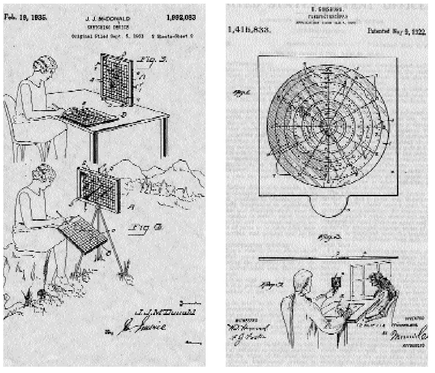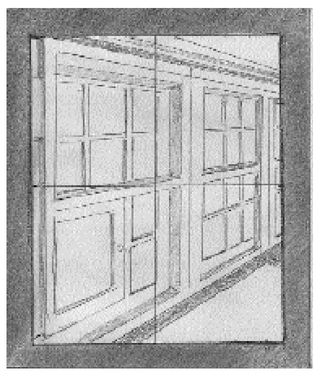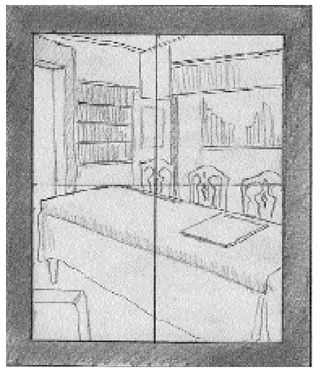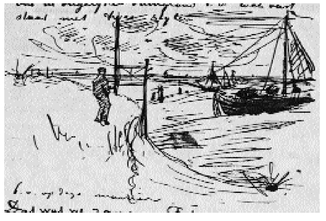The New Drawing on the Right Side of the Brain (23 page)
Read The New Drawing on the Right Side of the Brain Online
Authors: Betty Edwards

BOOK: The New Drawing on the Right Side of the Brain
2.36Mb size Format: txt, pdf, ePub
Dozens of picture planes and perspective devices are recorded in the U.S. Patent Office. Here are two examples.

Later on, you will need neither the plastic Picture Plane with its gridlines nor the Viewfinders. You will replace these technical devices with the imaginary, internalized mental picture-plane that every artist uses, whether consciously or subconsciously. The actual plane (your plastic Picture Plane) and the actual Viewfinders are simply very effective aids during the time you are learning how to draw.
Try this: Fasten your Viewfinder, the one with the largest opening, on top of the Picture Plane, using your clips. Close one eye and hold the Picture Plane/Viewfinder together up in front of your face. See Figure 6-8.
Look at the “framed” image, whatever is in front of your eye (singular). You can change the “composition” by bringing the Viewfinder closer to or farther away from your face, much as a camera viewfinder works. Check out the angles of the edges of the ceiling, or perhaps of a table, relative to the crosshairs—that is, relative to vertical and horizontal. These angles may surprise you. Next, imagine that you are drawing with your felt-tip marker what you see on the plane, just as you did in drawing your hand. See Figure 6-9.
Then turn to see another view, and then another, always keeping the picture-plane parallel to the front of your face. Don’t slant it in any direction! One way to practice not slanting the plane is to bring the plastic Picture Plane right up to your face, then quickly extend your arms straight out together.
Next, choose a view that you like, framed by your Viewfinder on the plastic Picture Plane. Imagine that you are “copying” what you see on the plane onto a piece of drawing paper. Remember, all of the angles, sizes, spaces, and relationships will be just what you see on the plane. See Figure 6-10.
These two images, your (imagined) drawing on the paper and the image on the plastic Picture Plane will be (approximately) the same. If perfectly drawn—very hard to do!—they will be identical. At its most basic level, that is what drawing is. To reiterate, basic realistic drawing is copying what is seen on the picture-plane.

Fig. 6-8.

Fig. 6-9.

Fig. 6-10.
“Dear Theo,
In my last letter you will have found a little sketch of that perspective frame I mentioned. I just came back from the blacksmith, who made iron points for the sticks and iron corners for the frame. It consists of two long stakes; the frame can be attached to them either way with strong wooden pegs.
“So on the shore or in the meadows or in the fields one can look through it
like a window
[the artist’s emphasis]. The vertical lines and the horizontal line of the frame and the diagonal lines and the intersection, or else the division in squares, certainly give a few pointers which help one make a solid drawing and which indicate the main lines and proportion . . . of why and how the perspective causes an apparent change of direction in the lines and change of size in the planes and in the whole mass.
like a window
[the artist’s emphasis]. The vertical lines and the horizontal line of the frame and the diagonal lines and the intersection, or else the division in squares, certainly give a few pointers which help one make a solid drawing and which indicate the main lines and proportion . . . of why and how the perspective causes an apparent change of direction in the lines and change of size in the planes and in the whole mass.
“Long and continuous practice with it enables one to draw quick as lightning—and once the drawing is done firmly, to paint quick as lightning, too.”
From Letter 223,
The Complete Letters of Vincent Van Gogh,
Greenwich, Conn.: The New York Graphic Society, 1954, p. 432-33.
The Complete Letters of Vincent Van Gogh,
Greenwich, Conn.: The New York Graphic Society, 1954, p. 432-33.
“If that is so,” you may object, “why not just take a photograph?” I believe one answer is that the purpose of realistic drawing is not simply to record data, but rather to record your unique perception—how you personally see something—and, moreover, how you understand the thing you are drawing. By slowing down and closely observing something, personal expression and comprehension occur in ways that cannot occur simply by taking a snapshot. (I am referring, of course, to casual photography, not the work of artist-photographers.)
Also, your style of line, choices for emphasis, and subconscious mental processes—your personality, so to speak—enters the drawing. In this way, again paradoxically, your careful observation and depiction of your subject give the viewer both the image of your subject and an insight into you. In the best sense, you have expressed yourself.
Use of the picture-plane has a long tradition in the history of art. The great Renaissance artist Leone Battista Alberti discovered that he could draw in perspective the cityscape beyond his window by drawing directly on the glass pane the view he saw behind the pane. Inspired by Leonardo da Vinci’s writing on the subject, German artist Albrecht Dürer developed the picture-plane concept further, building actual picture-plane devices. Dürer’s writings and drawings inspired Vincent Van Gogh to construct his own “perspective device,” as he called it, when he was laboriously teaching himself to draw (see Figure 6-11). Later on, after Van Gogh had mastered basic drawing, he discarded his device, just as you will.
Note that Van Gogh’s device must have weighed twenty pounds or more. I can picture him in my mind’s eye laboriously dismantling the parts, tying them up, carrying the bundle—along with his painting materials—on his long walk to the seashore, unbundling and setting the device up, and then repeating the whole sequence to get home at night. This gives us some insight into how resolutely Van Gogh labored to improve his drawing skills (see Figure 6-12).

Fig. 6-11. Vincent Van Gogh’s perspective device.

Fig. 6-12. The artist using his device at the seashore.
From
The Complete Letters of Vincent Van Gogh.
Greenwich: The New York Graphic Society, 1954. The drawings are reproduced by permission of The New York Graphic Society.
The Complete Letters of Vincent Van Gogh.
Greenwich: The New York Graphic Society, 1954. The drawings are reproduced by permission of The New York Graphic Society.
Another renowned artist, the 16th-century Dutch master Hans Holbein, who had no need for help with his drawing, also used an actual Picture Plane. Art historians recently discovered that Holbein used a glass pane on which he directly drew images of his sitters for the overwhelming number of portrait drawings required of him when he lived in the English court of Henry VIII. Art historians speculate that Holbein, one of the great draughtsmen of art history, did this to save time—the overworked artist could then quickly transfer the drawing on glass to paper and get on to the next portrait.
One more important point: “Drawing” means drawing a single view.
Recall that when you drew your hand directly on the plastic Picture Plane, I asked you to keep your hand still and your head still in order to see one view only on the Picture Plane. Even a slight movement of your hand or a slight change in the position of your head will give you a different view of your hand. I some- times see students bend their heads around to see something they couldn’t see with their head in the original position. Don’t do it! If you can’t see that fourth finger, you don’t draw it. To repeat: Keep your hand and your head in an unchanged position and draw just what you see.
Professor Elliot Elgart of the University of California at Los Angeles Art Department told me in conversation that he has often observed beginning drawing students, presented for the first time with a reclining model, tilt their heads far to one side while drawing the model. Why? To see the model in the position they are used to, which is standing up!
For the same reason—to see one view only—you kept one eye closed. By closing one eye, you removed binocular vision, the slight variance in images, called “binocular disparity,” that occurs when we view an object with both eyes open.
Binocular vision allows us to see the world as three-dimensional. This ability is sometimes called “depth perception.” When you close one eye, the single image is two-dimensional—that is, it is flat, like a photograph. The paper we draw on is also two-dimensional or flat.
Seeing perspective drawing as depicting three-dimensional space is apparently a learned percept, culturally determined. Individuals from remote cultures sometimes do not decipher photographs or realistic drawings.
Other books
Shake Hands With the Devil by Romeo Dallaire
The Passion by Boyd, Donna
The Last Road Home by Danny Johnson
Winds of Fortune by Radclyffe
thenoondaydemon by Anastasia Rabiyah
The Love Square by Jessica Calla
The Gift-Giver by Joyce Hansen
The One That Got Away by M. B. Feeney
That Girl by H.J. Bellus
Whirlwind by Nancy Martin